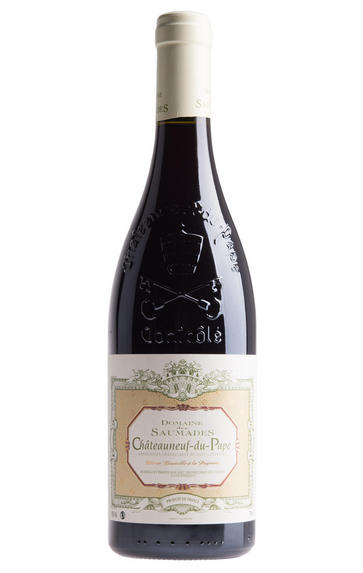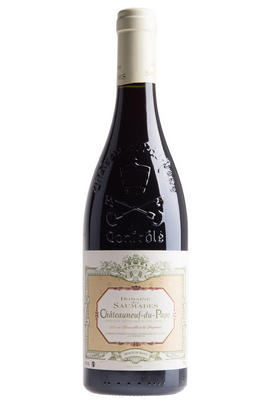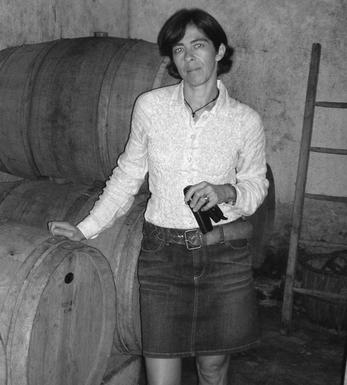
2020 Châteauneuf-du-Pape Rouge, Domaine des Saumades, Rhône

Critics reviews
Lots of classic ripe black cherry and blackberry fruits as well as licorice and peppery garrigue emerge from the 2020 Châteauneuf Du Pape, a medium to full-bodied, rich, impressively concentrated, chewy wine offering classic character and richness. It's going to benefit from a handful of years in the cellar and have 10-15 years of overall longevity.
Jeb Dunnuck, jebdunnuck.com (Nov 2021)
About this WINE

Domaine Des Saumades
Four generations of Moussets have been winemakers in Châteauneuf-du-Pape. However, in 1995, Frank Mousset, whose day job is at another winery with his brother-in-law, was approached to buy a 2.5-hectare parcel in the Pignan lieu-dit, beside Château Rayas. Franck and wife Murielle, then opened Domaine des Saumades, only making wine here.
The sandy soils here are perfect for Grenache. Franck also had the foresight to plant Mourvèdre here around six years ago. He believes Mourvèdre is key to countering the effects of climate change on Châteauneuf-du-Pape’s wines. Adding freshness, balance and Franck says, getting better annually in this parcel (currently, converting to organic certification). Since 2019 he has added 10% Mourvèdre into his otherwise pure Grenache red wine. The wines were very good but, with Mourvèdre, they are stunning. The white, typically 50% Grenache Blanc, 25% Clairette and 25% Bourboulenc, displays myriad flavours from fresh citrus to warming vanilla. This is what Châteauneuf-du-Pape is all about.

Châteauneuf-du-Pape
The most celebrated village of the Southern Rhône, Châteauneuf-du-Pape is the birthplace of the now indispensable French Appellation d’Origine Contrôlée system – imperfect though it may be. Compared to the Northern Rhône, the vineyards here are relatively flat and often feature the iconic galet pebbles – the precise benefits of which are a source of much debate. Minimum alcohol levels required by the AOC are the highest in France, but at 12.5% it is well below the natural generosity of Grenache, which only achieves its full aromatic potential when it is fully ripe and laden with the resultant high sugars. Syrah and Mourvèdre contribute the other defining elements in the blend, adding pepper, savoury spice and structure to the decadent Grenache. There are a further 10 permitted red grape varieties which can be used to adjust the “seasoning”. Of the five white varieties permitted, it is Grenache Noir’s sibling – predictably perhaps – Grenache Blanc, which dominates, though Roussanne shows a great deal of promise when handled well, notably at Château de Beaucastel.

Grenache/Garnacha
Grenache (Noir) is widely grown and comes in a variety of styles. Believed to originate in Spain, it was, in the late 20th century, the most widely planted black grape variety in the world. Today it hovers around seventh in the pecking order. It tends to produce very fruity, rich wines that can range quite widely in their level of tannin.
In many regions – most famously the Southern Rhône, where it complements Syrah and Mourvèdre, among other grapes – it adds backbone and colour to blends, but some of the most notable Châteauneuf du Pape producers (such as Château Rayas) make 100 percent Grenache wines. The grape is a component in many wines of the Languedoc (where you’ll also find its lighter-coloured forms, Grenache Gris and Blanc) and is responsible for much southern French rosé – taking the lead in most Provence styles.
Found all over Spain as Garnacha Tinta (spelt Garnaxa in Catalonia), the grape variety is increasingly detailed on wine labels there. Along with Tempranillo, it forms the majority of the blend for Rioja’s reds and has been adopted widely in Navarra, where it produces lighter styles of red and rosado (rosé). It can also be found operating under a pseudonym, Cannonau, in Sardinia.
Beyond Europe, Grenache is widely planted in California and Australia, largely thanks to its ability to operate in high temperatures and without much water. Particularly in the Barossa Valley, there are some extraordinary dry-farmed bush vines, some of which are centuries old and produce wines of startling intensity.


Buying options
Add to wishlist
Description
Sandy soils can bring perfume to a Châteauneuf-du-Pape and never has this been more evident that in the 2020 Saumades Rouge. It has a gorgeous, lifted nose of lilac mixed with juicy black cherries. The palate is full of ripe, creamy blackberries with a hint, unbelievably, of Eccles Cake. Although the fruit is rich, a beautiful freshness dominates the wine, along with plentiful tannins which most definitely have grip at this stage but which resolve harmoniously on the unbelievably long finish. Sensational. Drink 2024-2036.
Catriona Felstead MW, Senior Buyer, Berry Bros. & Rudd (Mar 2022)
wine at a glance
Delivery and quality guarantee